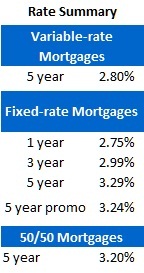David Larock in Mortgages and Finance, Home Buying
 Let’s begin the new year where we finished off the last one - in the euro zone.
Let’s begin the new year where we finished off the last one - in the euro zone.
After a brief period of calm as the calendar flipped to 2012, bond yields in the euro zone’s vulnerable member states are moving higher again. Most notably, Italian bond yields closed at 7.13% on Friday. This is significant because Greece, Ireland, and Portugal all sought bailouts shortly after their ten-year government bond yields breached the 7% threshold, and Italy’s bond market, the third largest in the world, is simply too big to save.
Italy’s current high borrowing costs will be of increasing importance in 2012 because the country must refinance more than US$ 400 billion worth of its existing bonds over the next twelve months. Having to roll over that debt at today’s rates will substantially increase Italy’s borrowing costs, expanding its budget deficit and further straining its government finances. It’s hard for me to see how Italy’s fragile economy, already absorbing harsh new austerity measures, will grow its way out of its current debt problems. I find it much easier to envision the knock-on effects of higher borrowing rates heightening investor fears and pushing interest costs higher still, in a self-perpetuating vicious cycle.
I’m not just picking on the Italians here. Spanish ten-year bond yields spiked up 0.6% last week, as the country revealed a wider than expected budget gap in 2011 (Spanish bond yields closed at 5.71% last Friday, but were as high as 6.7% only six short weeks ago). Keep in mind that Italian and Spanish bond yields are this high despite the fact that the European Central Bank (ECB) has bought about US$ 250 billion worth of sovereign debt since the euro-zone crisis began.
The ECB also recently extended three-year loans totalling about US$ 600 billion to more than five hundred European banks at a super-low 1% interest rate. This was done both as an attempt to ward off the immediate threat of a bank-induced credit crunch, and in the hope that the re-liquified banks would then lend that money to euro-zone governments in need. This attempt by the ECB to stave off a threat and to exit the sovereign debt buying business in one fell swoop may have been controversial, but it’s chilling to think where Europe would be without the ECB’s unprecedented actions.
Closer to home, Statistics Canada released its December employment report, and it was weak across the board. Employment reports are important indicators of where mortgage rates are headed because they tell you whether labour is likely to become more expensive in future. Labour is a pervasive cost that spreads throughout the economy, and higher labour costs spur broad-based price inflation and, by association, higher mortgage rates
While we gained 17,500 jobs last month, the bad news in the detail was that we lost 25,500 full-time jobs and gained 43,000 new part-time jobs instead. Our overall unemployment rate is now at an eight-month high of 7.5% and average hourly earnings have fallen 0.7%. So we have increasing slack in the labour market and the cost of labour is falling – no signs of inflationary wage pressure threatening to drive our mortgage rates higher at this point.
Five-year Government of Canada (GoC) bond yields were down about three basis points for the week, closing at 1.25% on Friday. Of the world’s fifteen largest economies, only three still enjoy stable AAA credit ratings (Canada, the U.K. and Australia). In an increasingly uncertain world, our government bonds are viewed as ultra-safe, and Canadian mortgage borrowers are direct beneficiaries with five-year fixed rates available at 3.29% or better.
Variable-mortgage rates are still at or a little below prime, which just isn’t compelling for most borrowers. With the spread between five-year fixed vs. variable-rate mortgages now down to .5%, it is much harder to justify the risk vs. reward trade-off of going with a variable rate.
The bottom line: As we begin the new year, all signs point to both fixed and variable-mortgage rates staying at their current levels, or edging lower for the foreseeable short-term future. The euro-zone crisis continues to stoke demand for our ultra-safe government bonds. Domestically, unemployment reports, like the one that Stats Can just released, suggest that growth, not inflation, will be our main concern in the coming months.
David Larock is an independent mortgage planner and industry insider specializing in helping clients purchase, refinance or renew their mortgages. David's posts appear weekly on this blog (movesmartly.com) and on his own blog integratedmortgageplanners.com/blog). Email Dave
January 9, 2012
Mortgage |


